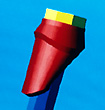
| |
||||
Procera® Abutments |
  |
|||
|
Abstracts
Factors that Influence the Retention of a Procera® AllCeram Crown Luted to a Customized Implant Abutment The Universal Acceptance of a CAD/CAM Created Abutment by Six Implant Systems Factors that Influence the Retention of a Procera® AllCeram Crown Luted to a Customized Implant Abutment Investigators: ZS Rashid, ME Razzoog, JB Dennison, KB May, and BR Lang Abstract:
The purpose of this study was to measure the tensile bond strength
of Procera® AllCeram copings cemented onto Procera® Custom
titanium abutments with varying taper and/or abutment heights and
using a eugenol provisional cement. Procera custom abutments were
fabricated using the Nobel Biocare 3D CAD/CAM program. The abutments
were designed in 4.0 and 8.0 mm heights. With the height held constant
at 4.0 mm, abutments were designed with 3.9° and 8° tapers.
Similarly 3.9° and 8° tapered abutments were designed in
the 8.0 mm height. The four (4) Procera custom abutments were scanned
by the Procera scanner and Procera aluminum oxide copings of 0.6
mm thickness were fabricated by Nobel Biocare, AB for each abutment.
The Procera custom abutments were positioned onto 3.75 Brånemark
implants and tighten using Unigrip® abutment screws. The implant/abutment
sample was positioned within a Universal Instron testing machine.
A Procera aluminum oxide coping was cemented onto the abutment using
the provisional cement Temp Bond NE. A load was applied by the Instron
machine to the Procera coping to measure the tensile strength needed
to remove the aluminum oxide coping from the titanium abutment.
All four implant/abutment/coping samples were test in this manner.
A significant difference (P=0.001) was demonstrated when the 4.0
mm abutment height (9.166 kg) was compared to the 8.0 mm abutment
height (34.55 kg) with the abutment taper held constant at 3.9°.
A significant difference (P=0.001) wad demonstrated when the 4.0
mm abutment height (6.69 kg) was compared to the 8.0 mm abutment
(30.21 kg) with the abutment taper held constant at 8°. A significant
difference (P=0.01) was demonstrated when the 3.9° abutment
taper (34.55 kg) was compared to the 8° abutment taper (30.21
kg) with the abutment height held constant at 8.0 mms. A significant
difference was not demonstrated (P=0.14) with the 3.9° tapered
abutment (9.16 kg) compared to the 8° abutment taper (6.69 kg)
with the abutment height held constant at 4.0 mm. The Universal Acceptance of a CAD/CAM Created Abutment by Six Implant System Investigators: LA Lang, M Hoffensburger, R-F Wang, ME Razzoog, and BR Lang Abstract:
The advantages of the custom design of the CAD/CAM Procera®
abutment warrants its evaluation for fit with the most commonly
used implant systems. If a precise fit can be achieved between the
hexagons of these implants and the hexagon of the Procera abutment,
then this abutment could be considered as a universal abutment for
these implant systems. Six implants were obtained for each of the
following implants systems. Brånemark - Conical Self-Tapping
3.75 X 10 mm implants, Implant Innovations Inc (3I) - 3.75 X 10
mm implants, Impla-Med - 3.75 X 10 mm implants, Paragon - Taper-Lock
4.0 X 10 mm, Lifecore - Restore 3.75 X 10 mm implants. The three-dimensional
external hexagon of each implant was measured, as was the internal
hexagon of six Procera custom abutment blanks. Procera abutments
were fabricated from Procera blanks and fitted onto the implant
abutments. The appropriate abutment screw was used for each implant
system to tighten the abutment using an electric torque controller
(Nobel Biocare AB, Göteborg, Sweden) and tightened to 32 Ncm.
Following tightening, the junction of the abutment to the implant
was photographed. Each sample was positioned in a holding device
oriented perpendicular to the long axis of a radiographic source
and radiographs were made. The mean hexagon dimensions for the implants
were: BrOEnemark Conical Self-Tapping 3.75 mm implant (2.69 mm widths
and 0.70 height), Implant Innovations Inc (3I) 3.75 mm implant (2.69
mm widths and 0.70 height), Impla-Med 3.75 mm implant (2.69 mm widths
and 0.69 height), Paragon Taper-Lock 4.0 mm implant (2.69 mm widths
and 0.79 height), and Lifecore Restore 3.75 mm implant (2.67 mm
widths and 0.81 height). The mean hexagon dimensions for the Procera
custom abutment internal hexagon was (2.73 mm widths and 0.90 mm
height). The photographs of each sample demonstrated a clinically
acceptable fit between the abutment and the implant. The radiographs
demonstrated that the implant screws in many instances were not
properly seating within the internal screw bore of the custom abutment.
The dimensions and design differences of the screw heads would not
permit proper seating of the screw head onto the clamping ledge
of the abutment bore. A preliminary examination of the fit of the
Procera abutment screw (Unigrip screw - Nobel Biocare AB, Göteborg,
Sweden) used to replace the abutment screw of each implant system
demonstrated that all of the non-Brånemark implants appeared
to accepted the Unigrip screw into the internal screw bore of the
implant.
|
||||
|
New
Projects | Origin of the Center
| Implants | Procera
| References Copyright
© 2001 |
||||
